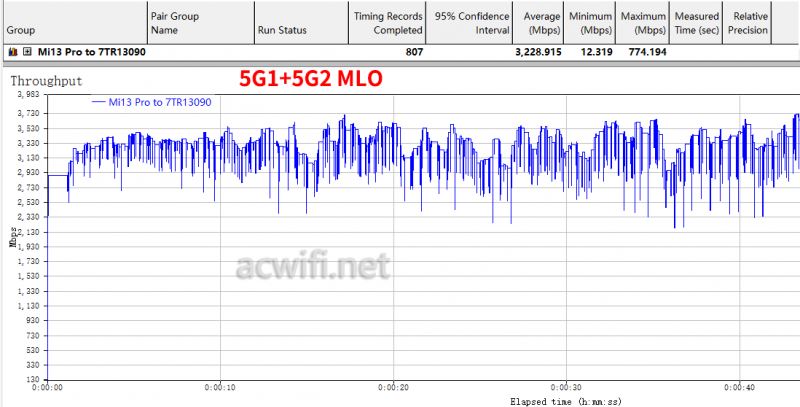用小米13 Pro和TP-LINK 7TR13090实测MLO效果
什么是MLO?我在一年前已经说过了。怎样查看路由器是否支持MLO、什么样的终端支持什么样的MLO,一个月前已经说过了。
怎样查看无线路由器支持MLO类型?从硬件、软件细说MLO支持的类型
现在来实测MLO的效果,为什么现在?因为现在才能满足MLO生效的条件 。这道菜的材料有7TR13090和小米13 Pro。

小米13 Pro已经买了一年,蚀到阿妈都吾认得!我这台手机最近一个月更新的版本是1.0.4.0UMBCNXM。即使你也是这个版本,也不一定能支持MLO。因为它的推送,不会把MLO驱动推送到100%的用户里面去,所以,是这个版本,但不一定有MLO驱动支持,也就是同遮吾同柄,同机吾同命。

小米13 Pro可以支持2.4G+5G的MLO,也支持双5G的MLO,现在的Wi-Fi 7无线路由器,只要有MLO选项,你把它开启,且把MLO的两个或三个频段改为相同的名称和密码,还要把加密方式选上WPA3,你也可以用WPA2/WPA3这个共存的选项。一定要用WPA3,一定要用WPA3,一定要用WPA3、既然你SSID名称和密码改为一样了,而没有选上WPA3,也是不能让MLO生效的。
一切准备就绪,怎么查看生效了没有?很简单,在无线路由器后台里查看连接的频段就可以了。为什么不在手机里查看?因为,现时的速率并没有叠加总和,仍然是2882Mbps:

我一年前就说过MLO是在MAC层进行的链路聚合动作,它只会有一个IP地址,在无线路由器后台终端列表也只会显示一个。
下图是7TR13090只用了2.4G+5G MLO的情况,显示小米13 Pro连接的无线频段有2个:2.4G和5G1

它也可以让5G1和5G2聚合MLO:

由于7TR13090是三频的,所以可以把三频都开启MLO。而小米13 Pro连接它开了三频的MLO时,手机也是双5G MLO。这三频Wi-Fi 7等于同时支持2.4G+5G MLO,5G1+5G2 MLO。
Intel BE200只支持2.4G+5G MLO,因为它只有两颗无线MAC,WCN7851可以支持5G1+5G2 MLO,因为它有三颗无线MAC。同样地,要看手机是否支持5G1+5G2 MLO,就要看它有没有把WCN7851中的三颗MAC去掉一颗。联发科和博通的我没见过世面,不不了解。
MLO需要驱动支持,还有win11的特定系统支持,我在前面的文章也说过了。到目前为止,系统是可以找到支持的,但无线网卡驱动还没有支持,即BE200和WCN7851还没有公版驱动支持。
下面把7TR13090的10G网口接入自建speedtest测速服务器,简单测试几次,小米13 Pro实测结果如下:

实了好多次,没办法上到3千兆。照理单频5G1在4096-QAM下可以到2300Mbps,单频5G2也能有1100Mbps,加起来会有3400Mbps的极限,这样上行下行都达不到。我猜是手机speedtest测速的瓶颈,是这种自建speedtest测速程序占去大量的CPU资源。这一点我很理解,就算电脑平台也会有speedtest测速性能瓶颈,差点的CPU就不准确了。那我换一种方式吧。用Ixchariot,这个测速对CPU占用小一些,只要不用小包来测。
下面是小米13 Pro 向7TR13090的5G打流的结果,达到了3228Mbps。嗯。就是这个速度!已经很接近极限值了。如果我耐心一点,不停地调速角度与距离,多测上百次,应该能有更好的数据。

2.4G +5G MLO 我由一年前已经说了,这种不实用,不如不用。实测也是如此,而且比单频5G更慢。真的不如不用,所以,大家对于现时那些双频的Wi-Fi 7,它的MLO不要有期望。2.4G就乖乖地做智能家居的无线接上点就OK了。你们在对双频Wi-Fi 7,开启MLO后,测速是不是更差了?
MLO是MAC层的东西,这是协议标准,不应该会有兼容的问题,包括4096-QAM,但标准的东西拿到人手里,总会有点小心思让自己的产品更有利。
由于时间限制,下次再拿小米7000来测一测双5G MLO。
可惜小米13 Pro不认100信道,否则我可以试一下160MHz+160MHz MLO的效果了。。。。。。
希望本篇让你们对MLO有一定尝试的理解。
相关文章
-

TPLINK 7TR13090路由器值得买吗? WiFi7双10G三频无线路由器拆机测评
TPLINK 7TR13090是一款wifi7路由器,这款路由器性能如何?值得购买吗?下面我们就来看看这款路由器wifi速度测评和拆机图2024-04-15 -

tplink路由器如何登录路由器管理界面? 路由器进入管理页面的方法
入手新路由器以后,需要登录管理页面进行设置,但是发现不知道怎么进入管理页面,今天我们就来看看tplink路由器进去管理页面的方法2024-03-15 -

tplink无线路由器无法登录管理界面怎么办? 路由器管理界面进入技巧
路由器进不去登陆管理界面的原因很多,用户操作上的错误、路由器不稳定/损坏等情况,都可能会导致无法进入tplink路由器的管理页面,下面我们就来看看详细的解决办法2024-03-15 -

tplink路由器使用TFTP工具升级失败怎么办? TFTP方式软件升级设置指南
路由器为了体验更好的的性能会进行升级,在使用tftp方式升级总是失败,该怎么解决呢?下面我们就来看看升级方法和遇到的问题解决2024-03-15 -

TP-LINK如何查看产品型号与硬件版本? tplink路由器型号查询图文教程
想要看看自己的路由器型号和版本,方便后期的升级,该怎么查看呢?今天我们就来介绍tplink查看型号和版本的三种方法2024-03-15 -

传统路由器怎么升级? TP-LINK传统路由器界面的升级方法
升级路由器固件是一项关键的操作,确保您的路由器始终保持最新的安全性、性能和功能,以下是一般情况下升级路由器固件的步骤2024-03-15 -

如何升级路由器的软件(固件)? TP-Link路由器升级教程
TPLink路由器想要升级体验新功能,该怎么进行升级呢?我们可以在线升级,也可以本地升级,具体的操作方法请看下文介绍2024-03-15 -

TL-R5408PB-AC一体机怎么样? TPLINK TL-R5408PB-AC路由器拆机测评
对于偏大户型wifi信号不好,TP-LINK为此提供了一套兼具专业性和便捷性的解决方案,通过PoE·AC一体化VPN路由器搭配各个房间的无线面板AP及路由器,提高wifi网络覆盖体验,2024-03-14 -

如何用TP-Link普联路由器连接另一个路由器? tplink桥接另一个路由器的
TP-Link路由器在使用的时候,想要桥接另一个路由器扩大wifi辐射范围,该怎么桥接?方法其实也很简单,详细请看下文介绍2024-03-11 -

华为路由 AX6 Pro与TP-LINK BE6500 Wi-Fi 7路由器哪款更值得买?
最近上了两款路由器,分别是华为路由 AX6 Pro与TP-LINK BE6500 ,这两款路由器配置如何?哪款更值得购买?详细请看下文介绍2024-02-19


最新评论